Surveillance Data Analysis: NUR 735 Homework Assignment
VerifiedAdded on 2022/09/14
|10
|2160
|17
Homework Assignment
AI Summary
This assignment analyzes influenza surveillance data from the CDC's FluView website, comparing trends from the first three months of 2018 and 2019 regarding influenza positive tests, pediatric mortality, and outpatient illness. The analysis explores the characteristics of novel influenza A viruses and identifies vulnerable populations, including pregnant women, the elderly, and young children, emphasizing the importance of public health measures. The study also examines the age groups most affected by different influenza viruses, such as A(H3), A(H1N1)pdm09, B(Victoria Lineage), and B(Yamagata Lineage). The assignment further discusses the role of epidemiology in public health, biostatistical methods, study designs, and the impact of genetics and environment on disease patterns. Finally, the assignment provides an overview of healthcare delivery, including the application of statistical data to develop healthcare services, using the example of the COVID-19 outbreak in Italy.
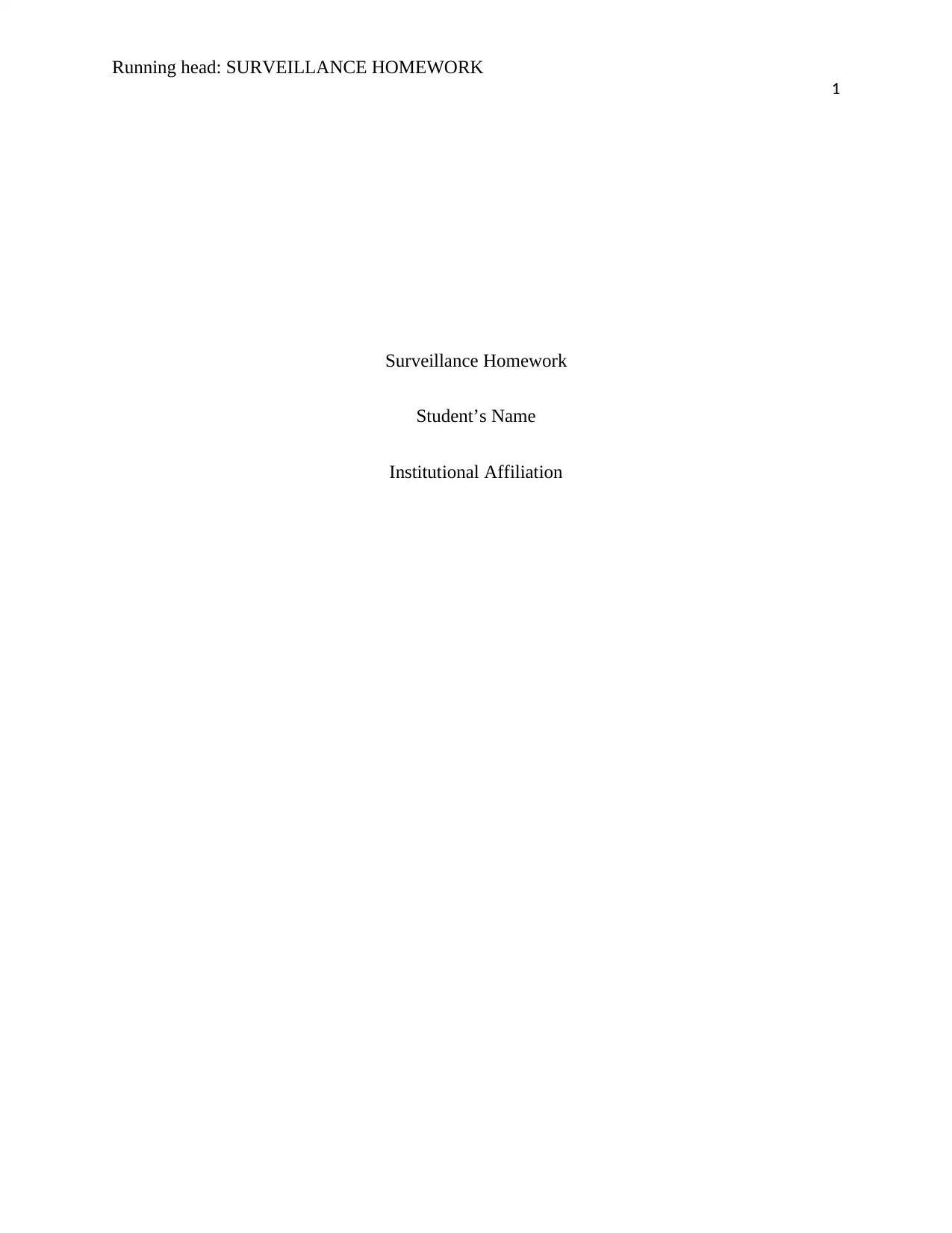
Running head: SURVEILLANCE HOMEWORK
1
Surveillance Homework
Student’s Name
Institutional Affiliation
1
Surveillance Homework
Student’s Name
Institutional Affiliation
Paraphrase This Document
Need a fresh take? Get an instant paraphrase of this document with our AI Paraphraser
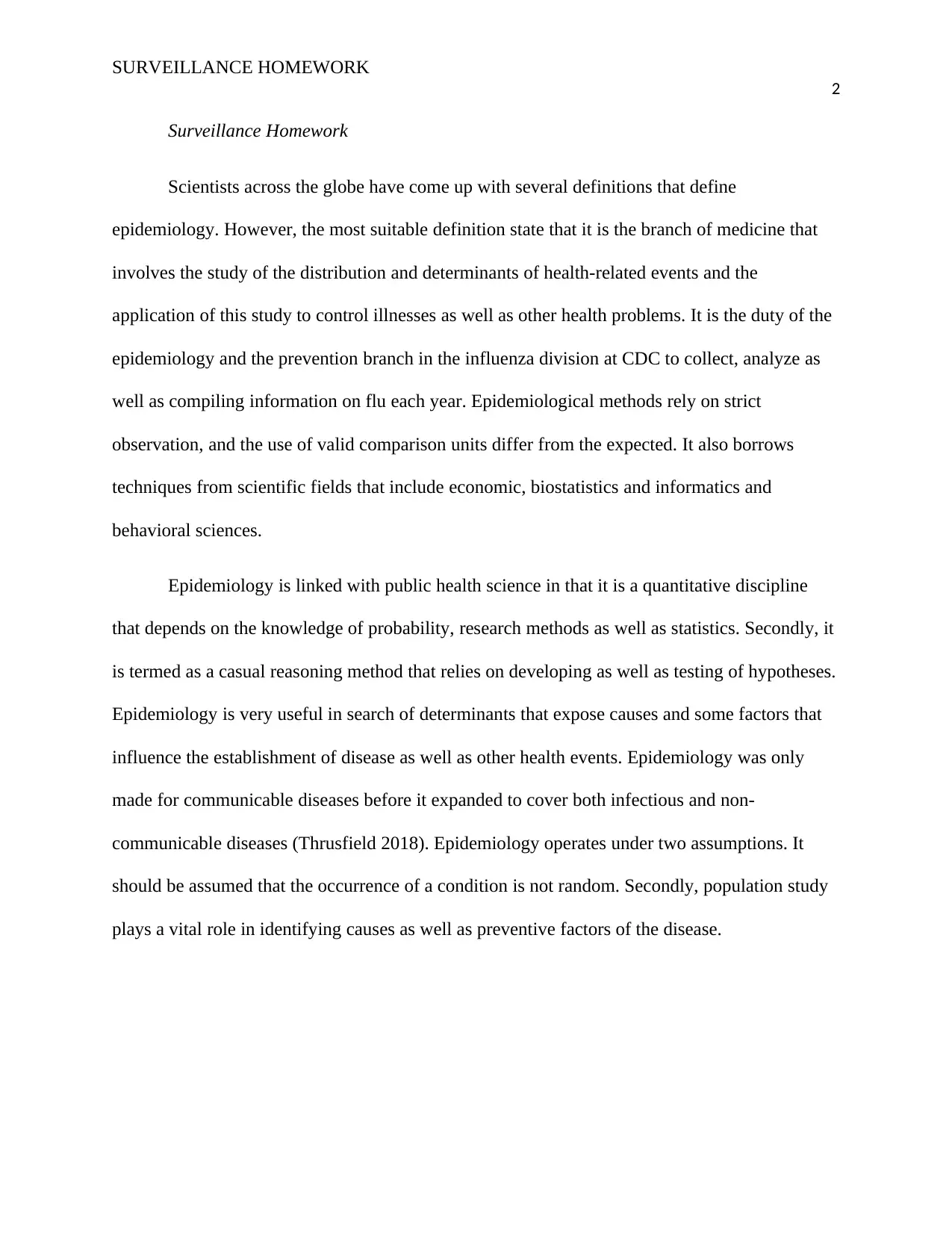
SURVEILLANCE HOMEWORK
2
Surveillance Homework
Scientists across the globe have come up with several definitions that define
epidemiology. However, the most suitable definition state that it is the branch of medicine that
involves the study of the distribution and determinants of health-related events and the
application of this study to control illnesses as well as other health problems. It is the duty of the
epidemiology and the prevention branch in the influenza division at CDC to collect, analyze as
well as compiling information on flu each year. Epidemiological methods rely on strict
observation, and the use of valid comparison units differ from the expected. It also borrows
techniques from scientific fields that include economic, biostatistics and informatics and
behavioral sciences.
Epidemiology is linked with public health science in that it is a quantitative discipline
that depends on the knowledge of probability, research methods as well as statistics. Secondly, it
is termed as a casual reasoning method that relies on developing as well as testing of hypotheses.
Epidemiology is very useful in search of determinants that expose causes and some factors that
influence the establishment of disease as well as other health events. Epidemiology was only
made for communicable diseases before it expanded to cover both infectious and non-
communicable diseases (Thrusfield 2018). Epidemiology operates under two assumptions. It
should be assumed that the occurrence of a condition is not random. Secondly, population study
plays a vital role in identifying causes as well as preventive factors of the disease.
2
Surveillance Homework
Scientists across the globe have come up with several definitions that define
epidemiology. However, the most suitable definition state that it is the branch of medicine that
involves the study of the distribution and determinants of health-related events and the
application of this study to control illnesses as well as other health problems. It is the duty of the
epidemiology and the prevention branch in the influenza division at CDC to collect, analyze as
well as compiling information on flu each year. Epidemiological methods rely on strict
observation, and the use of valid comparison units differ from the expected. It also borrows
techniques from scientific fields that include economic, biostatistics and informatics and
behavioral sciences.
Epidemiology is linked with public health science in that it is a quantitative discipline
that depends on the knowledge of probability, research methods as well as statistics. Secondly, it
is termed as a casual reasoning method that relies on developing as well as testing of hypotheses.
Epidemiology is very useful in search of determinants that expose causes and some factors that
influence the establishment of disease as well as other health events. Epidemiology was only
made for communicable diseases before it expanded to cover both infectious and non-
communicable diseases (Thrusfield 2018). Epidemiology operates under two assumptions. It
should be assumed that the occurrence of a condition is not random. Secondly, population study
plays a vital role in identifying causes as well as preventive factors of the disease.
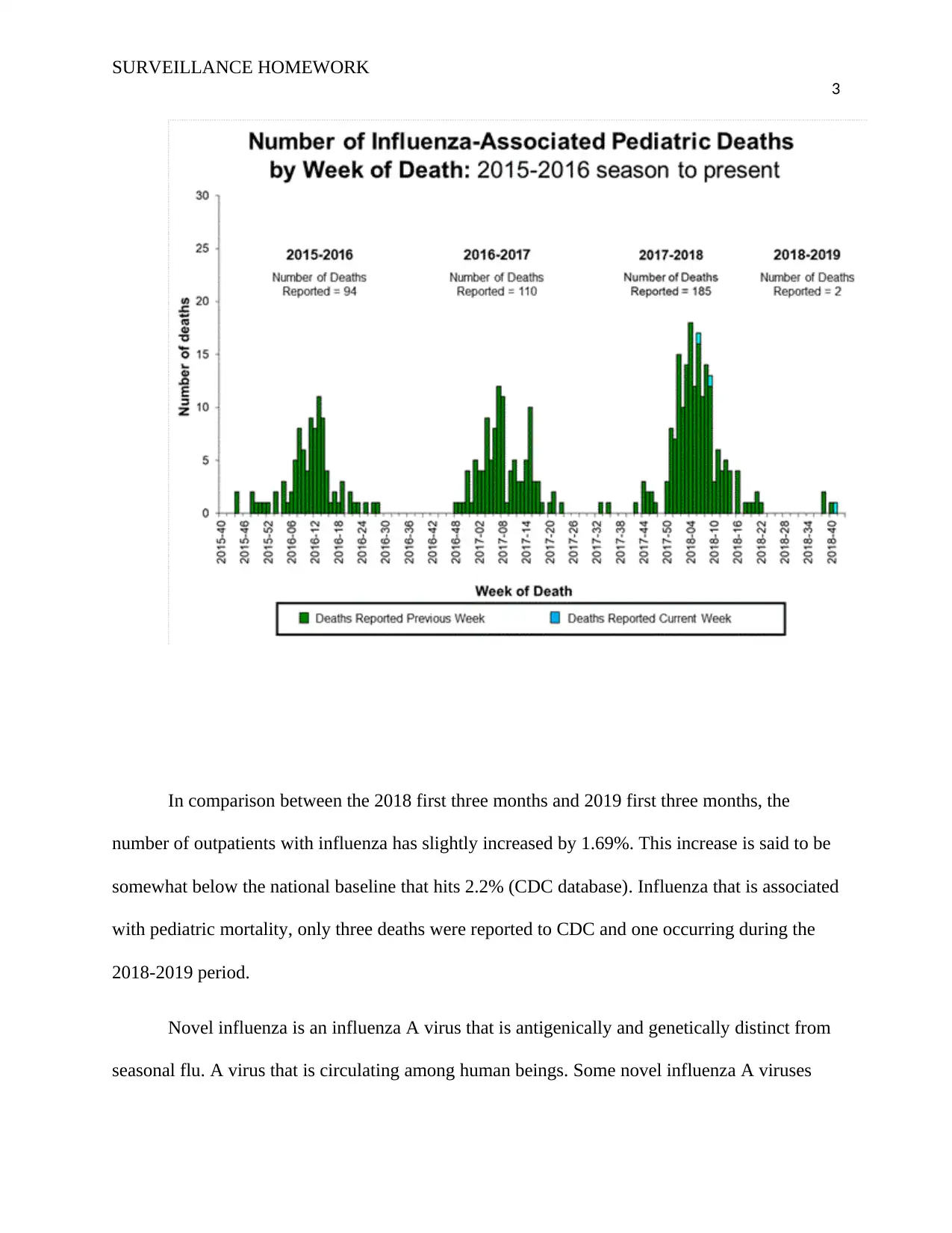
SURVEILLANCE HOMEWORK
3
In comparison between the 2018 first three months and 2019 first three months, the
number of outpatients with influenza has slightly increased by 1.69%. This increase is said to be
somewhat below the national baseline that hits 2.2% (CDC database). Influenza that is associated
with pediatric mortality, only three deaths were reported to CDC and one occurring during the
2018-2019 period.
Novel influenza is an influenza A virus that is antigenically and genetically distinct from
seasonal flu. A virus that is circulating among human beings. Some novel influenza A viruses
3
In comparison between the 2018 first three months and 2019 first three months, the
number of outpatients with influenza has slightly increased by 1.69%. This increase is said to be
somewhat below the national baseline that hits 2.2% (CDC database). Influenza that is associated
with pediatric mortality, only three deaths were reported to CDC and one occurring during the
2018-2019 period.
Novel influenza is an influenza A virus that is antigenically and genetically distinct from
seasonal flu. A virus that is circulating among human beings. Some novel influenza A viruses
⊘ This is a preview!⊘
Do you want full access?
Subscribe today to unlock all pages.

Trusted by 1+ million students worldwide
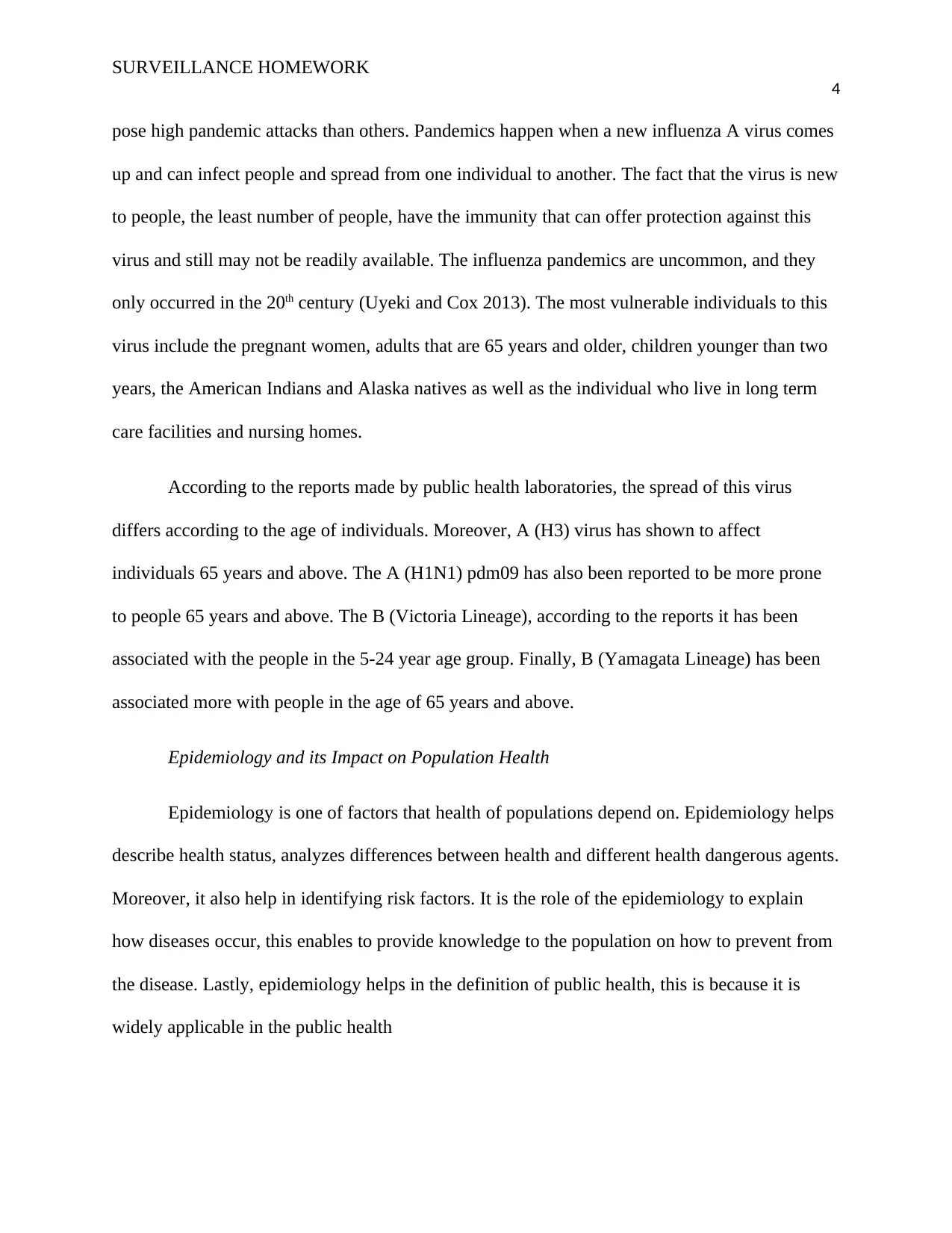
SURVEILLANCE HOMEWORK
4
pose high pandemic attacks than others. Pandemics happen when a new influenza A virus comes
up and can infect people and spread from one individual to another. The fact that the virus is new
to people, the least number of people, have the immunity that can offer protection against this
virus and still may not be readily available. The influenza pandemics are uncommon, and they
only occurred in the 20th century (Uyeki and Cox 2013). The most vulnerable individuals to this
virus include the pregnant women, adults that are 65 years and older, children younger than two
years, the American Indians and Alaska natives as well as the individual who live in long term
care facilities and nursing homes.
According to the reports made by public health laboratories, the spread of this virus
differs according to the age of individuals. Moreover, A (H3) virus has shown to affect
individuals 65 years and above. The A (H1N1) pdm09 has also been reported to be more prone
to people 65 years and above. The B (Victoria Lineage), according to the reports it has been
associated with the people in the 5-24 year age group. Finally, B (Yamagata Lineage) has been
associated more with people in the age of 65 years and above.
Epidemiology and its Impact on Population Health
Epidemiology is one of factors that health of populations depend on. Epidemiology helps
describe health status, analyzes differences between health and different health dangerous agents.
Moreover, it also help in identifying risk factors. It is the role of the epidemiology to explain
how diseases occur, this enables to provide knowledge to the population on how to prevent from
the disease. Lastly, epidemiology helps in the definition of public health, this is because it is
widely applicable in the public health
4
pose high pandemic attacks than others. Pandemics happen when a new influenza A virus comes
up and can infect people and spread from one individual to another. The fact that the virus is new
to people, the least number of people, have the immunity that can offer protection against this
virus and still may not be readily available. The influenza pandemics are uncommon, and they
only occurred in the 20th century (Uyeki and Cox 2013). The most vulnerable individuals to this
virus include the pregnant women, adults that are 65 years and older, children younger than two
years, the American Indians and Alaska natives as well as the individual who live in long term
care facilities and nursing homes.
According to the reports made by public health laboratories, the spread of this virus
differs according to the age of individuals. Moreover, A (H3) virus has shown to affect
individuals 65 years and above. The A (H1N1) pdm09 has also been reported to be more prone
to people 65 years and above. The B (Victoria Lineage), according to the reports it has been
associated with the people in the 5-24 year age group. Finally, B (Yamagata Lineage) has been
associated more with people in the age of 65 years and above.
Epidemiology and its Impact on Population Health
Epidemiology is one of factors that health of populations depend on. Epidemiology helps
describe health status, analyzes differences between health and different health dangerous agents.
Moreover, it also help in identifying risk factors. It is the role of the epidemiology to explain
how diseases occur, this enables to provide knowledge to the population on how to prevent from
the disease. Lastly, epidemiology helps in the definition of public health, this is because it is
widely applicable in the public health
Paraphrase This Document
Need a fresh take? Get an instant paraphrase of this document with our AI Paraphraser
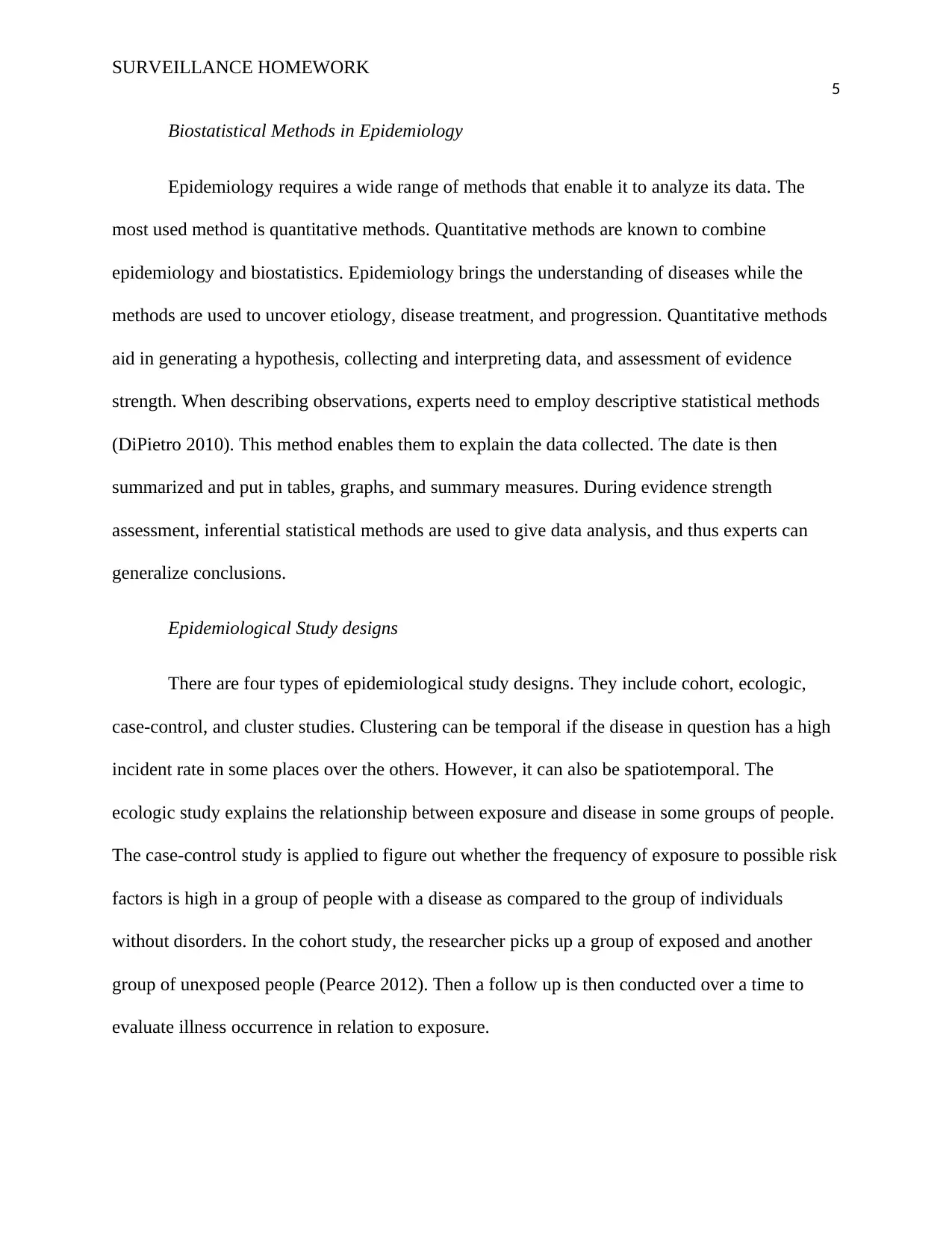
SURVEILLANCE HOMEWORK
5
Biostatistical Methods in Epidemiology
Epidemiology requires a wide range of methods that enable it to analyze its data. The
most used method is quantitative methods. Quantitative methods are known to combine
epidemiology and biostatistics. Epidemiology brings the understanding of diseases while the
methods are used to uncover etiology, disease treatment, and progression. Quantitative methods
aid in generating a hypothesis, collecting and interpreting data, and assessment of evidence
strength. When describing observations, experts need to employ descriptive statistical methods
(DiPietro 2010). This method enables them to explain the data collected. The date is then
summarized and put in tables, graphs, and summary measures. During evidence strength
assessment, inferential statistical methods are used to give data analysis, and thus experts can
generalize conclusions.
Epidemiological Study designs
There are four types of epidemiological study designs. They include cohort, ecologic,
case-control, and cluster studies. Clustering can be temporal if the disease in question has a high
incident rate in some places over the others. However, it can also be spatiotemporal. The
ecologic study explains the relationship between exposure and disease in some groups of people.
The case-control study is applied to figure out whether the frequency of exposure to possible risk
factors is high in a group of people with a disease as compared to the group of individuals
without disorders. In the cohort study, the researcher picks up a group of exposed and another
group of unexposed people (Pearce 2012). Then a follow up is then conducted over a time to
evaluate illness occurrence in relation to exposure.
5
Biostatistical Methods in Epidemiology
Epidemiology requires a wide range of methods that enable it to analyze its data. The
most used method is quantitative methods. Quantitative methods are known to combine
epidemiology and biostatistics. Epidemiology brings the understanding of diseases while the
methods are used to uncover etiology, disease treatment, and progression. Quantitative methods
aid in generating a hypothesis, collecting and interpreting data, and assessment of evidence
strength. When describing observations, experts need to employ descriptive statistical methods
(DiPietro 2010). This method enables them to explain the data collected. The date is then
summarized and put in tables, graphs, and summary measures. During evidence strength
assessment, inferential statistical methods are used to give data analysis, and thus experts can
generalize conclusions.
Epidemiological Study designs
There are four types of epidemiological study designs. They include cohort, ecologic,
case-control, and cluster studies. Clustering can be temporal if the disease in question has a high
incident rate in some places over the others. However, it can also be spatiotemporal. The
ecologic study explains the relationship between exposure and disease in some groups of people.
The case-control study is applied to figure out whether the frequency of exposure to possible risk
factors is high in a group of people with a disease as compared to the group of individuals
without disorders. In the cohort study, the researcher picks up a group of exposed and another
group of unexposed people (Pearce 2012). Then a follow up is then conducted over a time to
evaluate illness occurrence in relation to exposure.
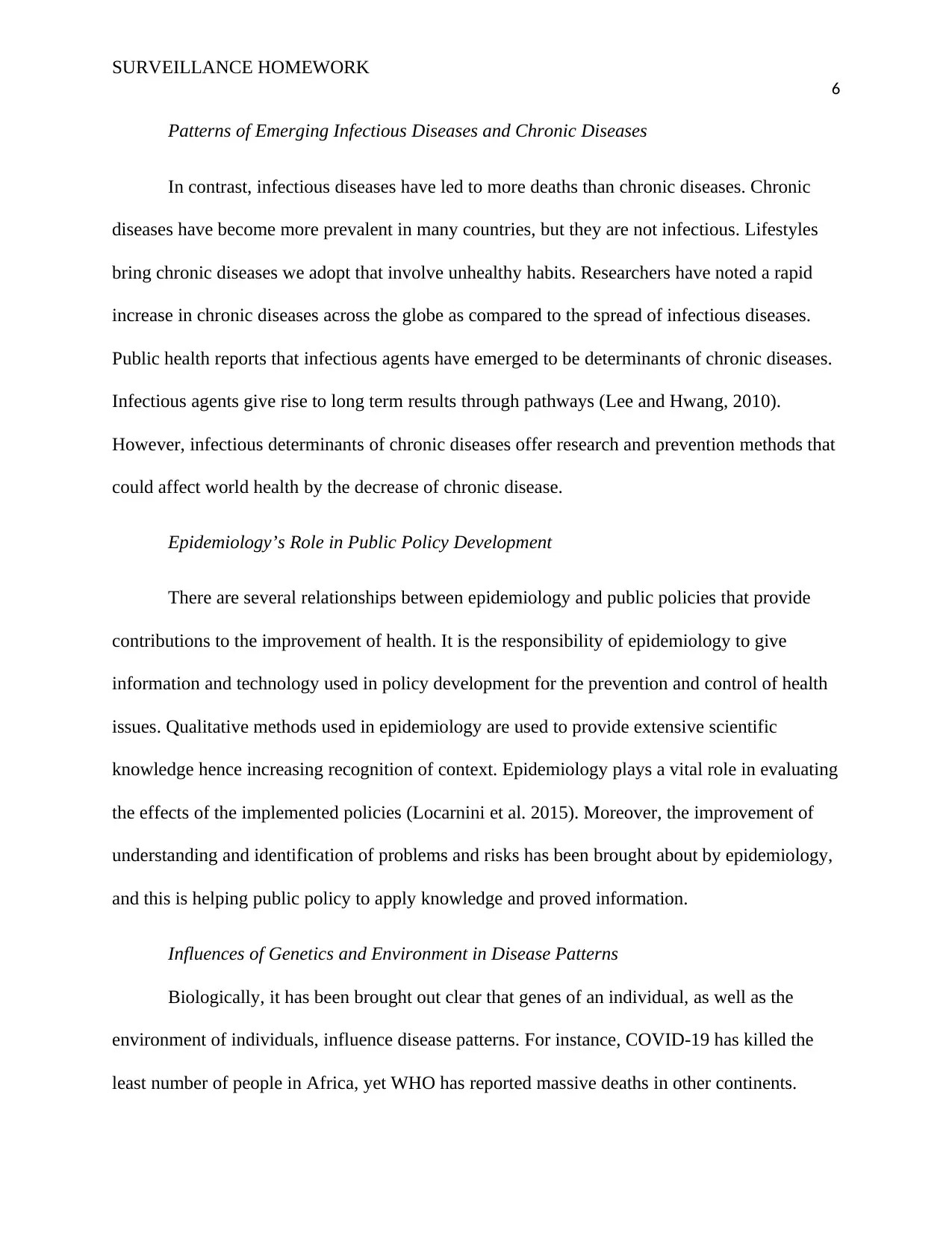
SURVEILLANCE HOMEWORK
6
Patterns of Emerging Infectious Diseases and Chronic Diseases
In contrast, infectious diseases have led to more deaths than chronic diseases. Chronic
diseases have become more prevalent in many countries, but they are not infectious. Lifestyles
bring chronic diseases we adopt that involve unhealthy habits. Researchers have noted a rapid
increase in chronic diseases across the globe as compared to the spread of infectious diseases.
Public health reports that infectious agents have emerged to be determinants of chronic diseases.
Infectious agents give rise to long term results through pathways (Lee and Hwang, 2010).
However, infectious determinants of chronic diseases offer research and prevention methods that
could affect world health by the decrease of chronic disease.
Epidemiology’s Role in Public Policy Development
There are several relationships between epidemiology and public policies that provide
contributions to the improvement of health. It is the responsibility of epidemiology to give
information and technology used in policy development for the prevention and control of health
issues. Qualitative methods used in epidemiology are used to provide extensive scientific
knowledge hence increasing recognition of context. Epidemiology plays a vital role in evaluating
the effects of the implemented policies (Locarnini et al. 2015). Moreover, the improvement of
understanding and identification of problems and risks has been brought about by epidemiology,
and this is helping public policy to apply knowledge and proved information.
Influences of Genetics and Environment in Disease Patterns
Biologically, it has been brought out clear that genes of an individual, as well as the
environment of individuals, influence disease patterns. For instance, COVID-19 has killed the
least number of people in Africa, yet WHO has reported massive deaths in other continents.
6
Patterns of Emerging Infectious Diseases and Chronic Diseases
In contrast, infectious diseases have led to more deaths than chronic diseases. Chronic
diseases have become more prevalent in many countries, but they are not infectious. Lifestyles
bring chronic diseases we adopt that involve unhealthy habits. Researchers have noted a rapid
increase in chronic diseases across the globe as compared to the spread of infectious diseases.
Public health reports that infectious agents have emerged to be determinants of chronic diseases.
Infectious agents give rise to long term results through pathways (Lee and Hwang, 2010).
However, infectious determinants of chronic diseases offer research and prevention methods that
could affect world health by the decrease of chronic disease.
Epidemiology’s Role in Public Policy Development
There are several relationships between epidemiology and public policies that provide
contributions to the improvement of health. It is the responsibility of epidemiology to give
information and technology used in policy development for the prevention and control of health
issues. Qualitative methods used in epidemiology are used to provide extensive scientific
knowledge hence increasing recognition of context. Epidemiology plays a vital role in evaluating
the effects of the implemented policies (Locarnini et al. 2015). Moreover, the improvement of
understanding and identification of problems and risks has been brought about by epidemiology,
and this is helping public policy to apply knowledge and proved information.
Influences of Genetics and Environment in Disease Patterns
Biologically, it has been brought out clear that genes of an individual, as well as the
environment of individuals, influence disease patterns. For instance, COVID-19 has killed the
least number of people in Africa, yet WHO has reported massive deaths in other continents.
⊘ This is a preview!⊘
Do you want full access?
Subscribe today to unlock all pages.

Trusted by 1+ million students worldwide
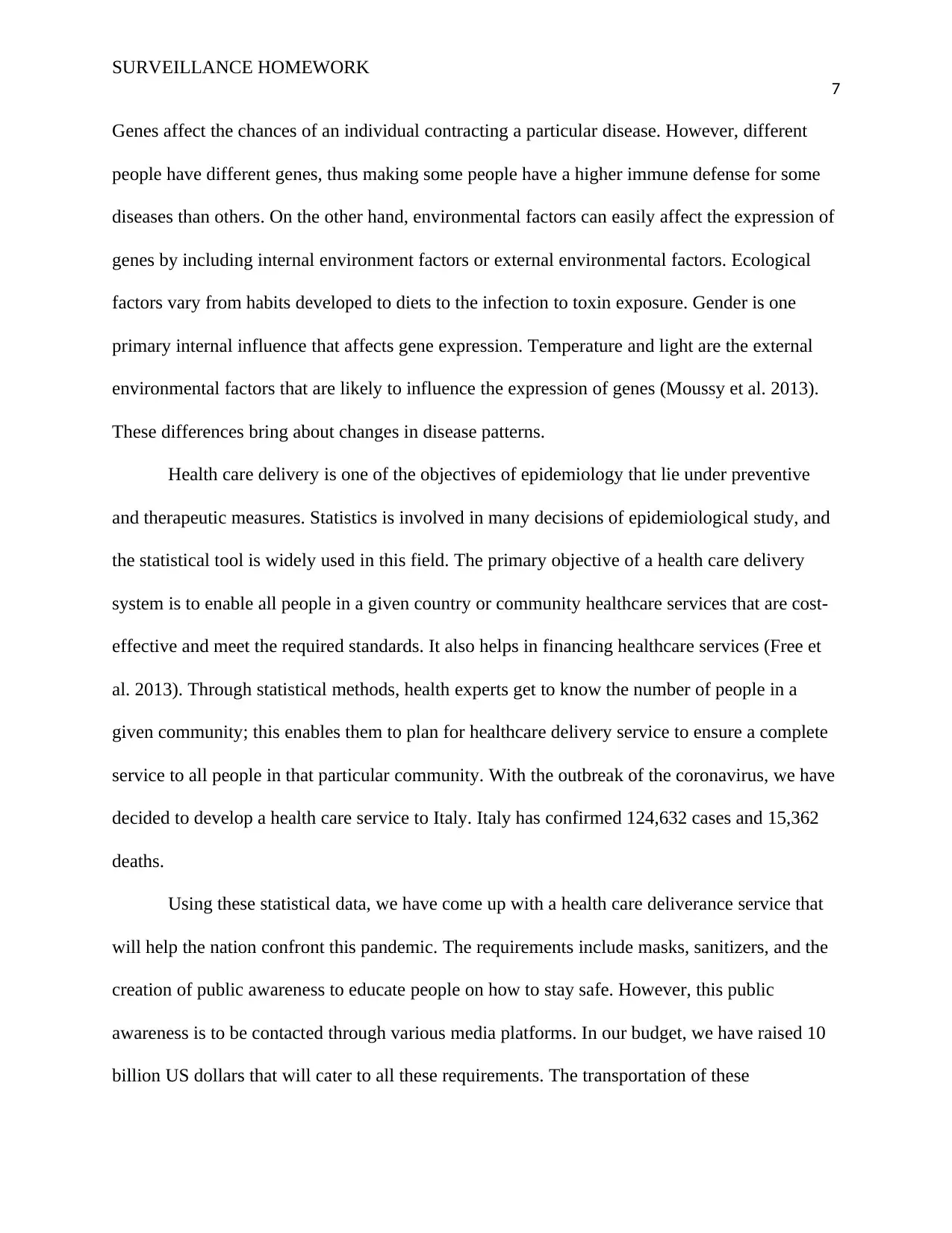
SURVEILLANCE HOMEWORK
7
Genes affect the chances of an individual contracting a particular disease. However, different
people have different genes, thus making some people have a higher immune defense for some
diseases than others. On the other hand, environmental factors can easily affect the expression of
genes by including internal environment factors or external environmental factors. Ecological
factors vary from habits developed to diets to the infection to toxin exposure. Gender is one
primary internal influence that affects gene expression. Temperature and light are the external
environmental factors that are likely to influence the expression of genes (Moussy et al. 2013).
These differences bring about changes in disease patterns.
Health care delivery is one of the objectives of epidemiology that lie under preventive
and therapeutic measures. Statistics is involved in many decisions of epidemiological study, and
the statistical tool is widely used in this field. The primary objective of a health care delivery
system is to enable all people in a given country or community healthcare services that are cost-
effective and meet the required standards. It also helps in financing healthcare services (Free et
al. 2013). Through statistical methods, health experts get to know the number of people in a
given community; this enables them to plan for healthcare delivery service to ensure a complete
service to all people in that particular community. With the outbreak of the coronavirus, we have
decided to develop a health care service to Italy. Italy has confirmed 124,632 cases and 15,362
deaths.
Using these statistical data, we have come up with a health care deliverance service that
will help the nation confront this pandemic. The requirements include masks, sanitizers, and the
creation of public awareness to educate people on how to stay safe. However, this public
awareness is to be contacted through various media platforms. In our budget, we have raised 10
billion US dollars that will cater to all these requirements. The transportation of these
7
Genes affect the chances of an individual contracting a particular disease. However, different
people have different genes, thus making some people have a higher immune defense for some
diseases than others. On the other hand, environmental factors can easily affect the expression of
genes by including internal environment factors or external environmental factors. Ecological
factors vary from habits developed to diets to the infection to toxin exposure. Gender is one
primary internal influence that affects gene expression. Temperature and light are the external
environmental factors that are likely to influence the expression of genes (Moussy et al. 2013).
These differences bring about changes in disease patterns.
Health care delivery is one of the objectives of epidemiology that lie under preventive
and therapeutic measures. Statistics is involved in many decisions of epidemiological study, and
the statistical tool is widely used in this field. The primary objective of a health care delivery
system is to enable all people in a given country or community healthcare services that are cost-
effective and meet the required standards. It also helps in financing healthcare services (Free et
al. 2013). Through statistical methods, health experts get to know the number of people in a
given community; this enables them to plan for healthcare delivery service to ensure a complete
service to all people in that particular community. With the outbreak of the coronavirus, we have
decided to develop a health care service to Italy. Italy has confirmed 124,632 cases and 15,362
deaths.
Using these statistical data, we have come up with a health care deliverance service that
will help the nation confront this pandemic. The requirements include masks, sanitizers, and the
creation of public awareness to educate people on how to stay safe. However, this public
awareness is to be contacted through various media platforms. In our budget, we have raised 10
billion US dollars that will cater to all these requirements. The transportation of these
Paraphrase This Document
Need a fresh take? Get an instant paraphrase of this document with our AI Paraphraser

SURVEILLANCE HOMEWORK
8
requirements will cost about 4.2 million US dollars. The sanitizers went for 3 million US dollars
and will be donated equally in every city. Masks' total number managed was 500,000 masks that
will be used and be restored in case the pandemic spreads out widely. The team that will be
going for the delivery will have 20 million for their expenses during these delivery services that
might take them a prolonged period.
To conclude, as discussed above, it has come out clearly that epidemiology is a relevant
field that has contributed to the wellness of the people. It is by this research that researchers can
set the goals of their operations within heights that enable them to reach every one around the
globe. A comprehensive discussion about influenza A virus was done, allowing the people to get
educated on means of prevention and the populations vulnerable to that disease.
8
requirements will cost about 4.2 million US dollars. The sanitizers went for 3 million US dollars
and will be donated equally in every city. Masks' total number managed was 500,000 masks that
will be used and be restored in case the pandemic spreads out widely. The team that will be
going for the delivery will have 20 million for their expenses during these delivery services that
might take them a prolonged period.
To conclude, as discussed above, it has come out clearly that epidemiology is a relevant
field that has contributed to the wellness of the people. It is by this research that researchers can
set the goals of their operations within heights that enable them to reach every one around the
globe. A comprehensive discussion about influenza A virus was done, allowing the people to get
educated on means of prevention and the populations vulnerable to that disease.
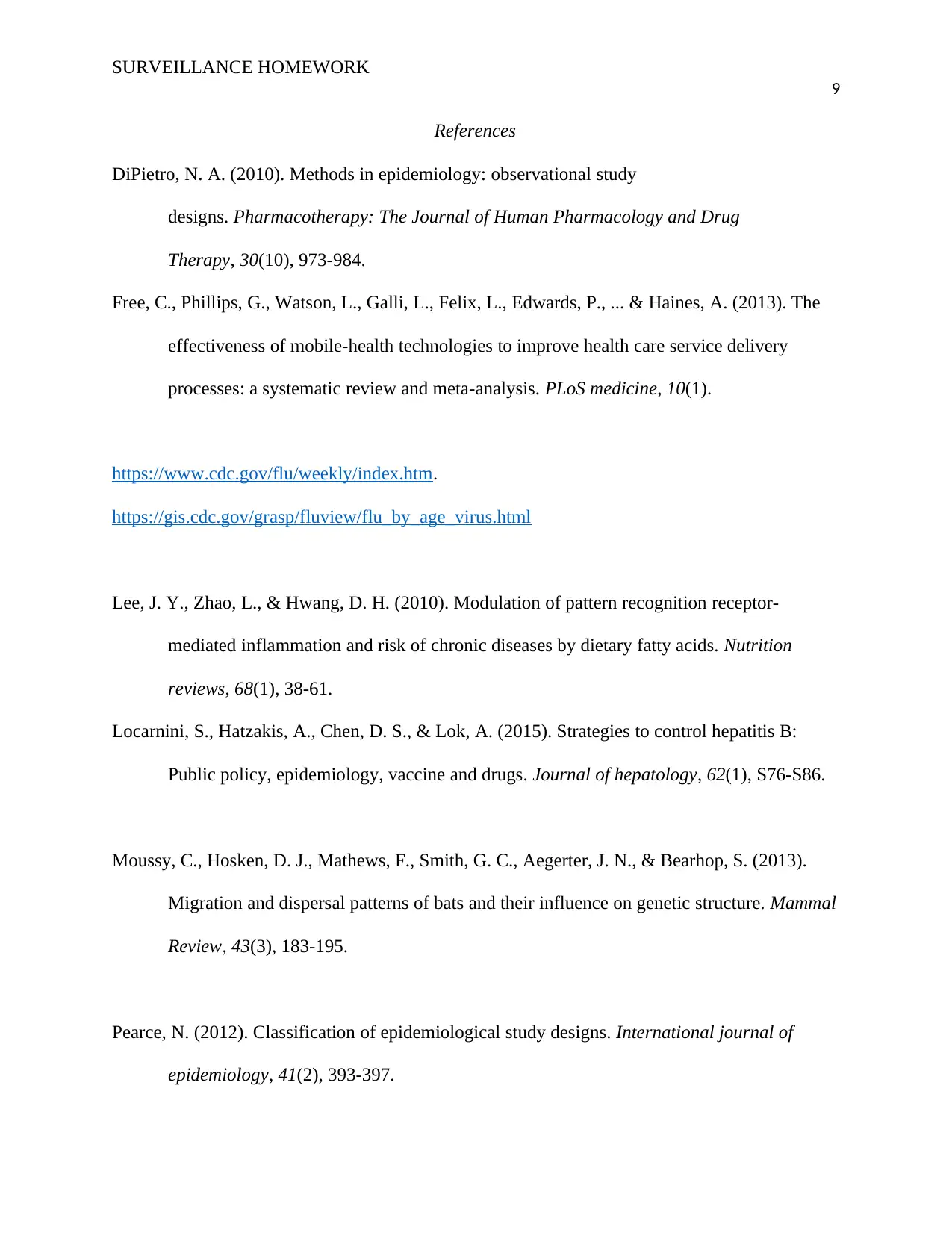
SURVEILLANCE HOMEWORK
9
References
DiPietro, N. A. (2010). Methods in epidemiology: observational study
designs. Pharmacotherapy: The Journal of Human Pharmacology and Drug
Therapy, 30(10), 973-984.
Free, C., Phillips, G., Watson, L., Galli, L., Felix, L., Edwards, P., ... & Haines, A. (2013). The
effectiveness of mobile-health technologies to improve health care service delivery
processes: a systematic review and meta-analysis. PLoS medicine, 10(1).
https://www.cdc.gov/flu/weekly/index.htm.
https://gis.cdc.gov/grasp/fluview/flu_by_age_virus.html
Lee, J. Y., Zhao, L., & Hwang, D. H. (2010). Modulation of pattern recognition receptor-
mediated inflammation and risk of chronic diseases by dietary fatty acids. Nutrition
reviews, 68(1), 38-61.
Locarnini, S., Hatzakis, A., Chen, D. S., & Lok, A. (2015). Strategies to control hepatitis B:
Public policy, epidemiology, vaccine and drugs. Journal of hepatology, 62(1), S76-S86.
Moussy, C., Hosken, D. J., Mathews, F., Smith, G. C., Aegerter, J. N., & Bearhop, S. (2013).
Migration and dispersal patterns of bats and their influence on genetic structure. Mammal
Review, 43(3), 183-195.
Pearce, N. (2012). Classification of epidemiological study designs. International journal of
epidemiology, 41(2), 393-397.
9
References
DiPietro, N. A. (2010). Methods in epidemiology: observational study
designs. Pharmacotherapy: The Journal of Human Pharmacology and Drug
Therapy, 30(10), 973-984.
Free, C., Phillips, G., Watson, L., Galli, L., Felix, L., Edwards, P., ... & Haines, A. (2013). The
effectiveness of mobile-health technologies to improve health care service delivery
processes: a systematic review and meta-analysis. PLoS medicine, 10(1).
https://www.cdc.gov/flu/weekly/index.htm.
https://gis.cdc.gov/grasp/fluview/flu_by_age_virus.html
Lee, J. Y., Zhao, L., & Hwang, D. H. (2010). Modulation of pattern recognition receptor-
mediated inflammation and risk of chronic diseases by dietary fatty acids. Nutrition
reviews, 68(1), 38-61.
Locarnini, S., Hatzakis, A., Chen, D. S., & Lok, A. (2015). Strategies to control hepatitis B:
Public policy, epidemiology, vaccine and drugs. Journal of hepatology, 62(1), S76-S86.
Moussy, C., Hosken, D. J., Mathews, F., Smith, G. C., Aegerter, J. N., & Bearhop, S. (2013).
Migration and dispersal patterns of bats and their influence on genetic structure. Mammal
Review, 43(3), 183-195.
Pearce, N. (2012). Classification of epidemiological study designs. International journal of
epidemiology, 41(2), 393-397.
⊘ This is a preview!⊘
Do you want full access?
Subscribe today to unlock all pages.

Trusted by 1+ million students worldwide

SURVEILLANCE HOMEWORK
10
Thrusfield, M. (2018). Veterinary epidemiology. John Wiley & Sons.
Uyeki, T. M., & Cox, N. J. (2013). Global concerns regarding novel influenza A (H7N9) virus
infections. New England Journal of Medicine, 368(20), 1862-1864.
10
Thrusfield, M. (2018). Veterinary epidemiology. John Wiley & Sons.
Uyeki, T. M., & Cox, N. J. (2013). Global concerns regarding novel influenza A (H7N9) virus
infections. New England Journal of Medicine, 368(20), 1862-1864.
1 out of 10
Related Documents
Your All-in-One AI-Powered Toolkit for Academic Success.
+13062052269
info@desklib.com
Available 24*7 on WhatsApp / Email
![[object Object]](/_next/static/media/star-bottom.7253800d.svg)
Unlock your academic potential
Copyright © 2020–2025 A2Z Services. All Rights Reserved. Developed and managed by ZUCOL.





